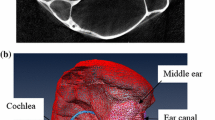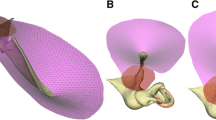Abstract
An accurate, comprehensive finite element model of the human ear can provide better understanding of sound transmission, and can be used for assessing the influence of diseases on hearing and the treatment of hearing loss. In this study, we proposed a three-dimensional finite element model of the human ear that included the external ear canal, tympanic membrane (eardrum), ossicular bones, middle ear suspensory ligaments/muscles, and middle ear cavity. This model was constructed based on a complete set of histological section images of a left ear temporal bone. The finite element (FE) model of the human ear was validated by comparing model-predicted ossicular movements at the stapes footplate and tympanic membrane with published experimental measurements on human temporal bones. The FE model was employed to predict the effects of eardrum thickness and stiffness, incudostapedial joint material, and cochlear load on acoustic-mechanical transmission through the human ossicular chain. The acoustic-structural coupled FE analysis between the ear canal air column and middle ear ossicles was also conducted and the results revealed that the peak responses of both tympanic membrane and stapes footplate occurred between 3000 and 4000 Hz.
Similar content being viewed by others
REFERENCES
Aibara, R., J. T. Welsh, S. Puria, and R. L. Goode. Human middle-ear sound transfer function and cochlear impedance. Hear. Res. 152:100–109, 2001.
Canalis, R. F., and P. R. Lambert. The EAR—Comprehensive Otology. Philadelphia: Lippincott Williams & Wilkins, 2000.
Cho, J. R., H. W. Lee, and K. W. Kim. Free vibration analysis of baffled liquid-storage tanks by the structural-acoustic finite element formulation. J. Sound Vibration 258:847–866, 2002.
Donaldson, J. A., and J. M. Miller. Anatomy of the ear. In: Basic Sciences and Related Disciplines, Otolaryngology, Vol. 1. Philadelphia: Saunders, 1973, pp. 75–110.
Funnell, W. R. J., and C. A. Laszlo. Modeling of the cat eardrum as a thin shell using the finite-element method. J. Acoust. Soc. Am. 63:1461–1467, 1978.
Gan, R. Z., R. K. Dyer, M. W. Wood, and K. J. Dormer. Mass loading on ossicles and middle ear function. Ann. Otol. Rhinol. Laryngol. 110:478–485, 2001.
Gan, R. Z., Q. Sun, R. K. Dyer, K.-H. Chang, and K. J. Dormer. Three dimensional modeling of middle ear biomechanics and its application. Otol. Neurotol. 23:271–280, 2002.
Gan, R. Z., M. W. Wood, and K. J. Dormer. Human middle ear transfer function measured by double laser interferometry system. Otol. Neurotol. 2004 (in press).
Gelfand, S. A. Hearing—An Introduction to Psychological and Physiological Acoustics. New York: Murcel Dekker, 1998, pp. 43–44.
Goode, R. L., M. Killion, K. Nakamura, and S. Nishihara. New knowledge about the function of the human middle ear: Development of an improved analog model. Am. J. Otol. 15:145–154, 1994.
Herrmann, G., and H. Liebowitz. Mechanics of bone fractures. In: Fracture: An Advanced Treatise, edited by H. Liebowitz. New York: Academic Press, 1972, pp. 772–840.
Hudde, H., and C. Weistenhöfer. A three-dimensional circuit model of the middle ear. Acustica United with Acta Acustica 83:535–549, 1997.
Kelly, D. J., P. J. Prendergast, and A. W. Blayney. The effect of prosthesis design on vibration of the reconstructed analysis of four prostheses. Otol. Neurotol. 24:11–19, 2003.
Kirikae, I. The Structure and Function of the Middle Ear. Tokyo: University of Tokyo Press, 1960.
Koike, T., and H. Wada. Modeling of the human middle ear using the finite-element method. J. Acoust. Soc. Am. 111:1306–1317, 2002.
Kringlebotn, M., and T. Gundersen. Frequency characteristics of the middle ear. J. Acoust. Soc. Am. 77:159–164, 1985.
Kringlebotn, M. Network model for the human middle ear. Scan Audiol. 17:75–85, 1988.
Lutman, M. E., and A. M. Martin. Development of an electroacoustic analogue model of the middle ear and acoustic reflex. J. Sound Vibration 64:133–157, 1979.
Lynch, T. J., V. Nedzelnitsky, and W. T. Peake. Input impedance of the cochlea in cat. J. Acoust. Soc. Am. 72:108–130, 1982.
Merchant, S. N., M. E. Ravicz, and J. J. Rosowski. Acoustic input impedance of the stapes and cochlea in human temporal bones. Hear. Res. 97:30–45, 1996.
Nishihara, S., and R. L. Goode. Measurement of tympanic membrane vibration in 99 human ears. In: Research and Otosurgery: Proceedings of the International Workshop on Middle Ear Mechanics in Research and Otosurgery, edited by K. B. Hüttenbrink: Dresden, Germany: Dresden University Press, 1997, pp. 91–93.
Prendergast, P. J., P. Ferris, H. J. Rice, and A. W. Blayncy. Vibro-acoustic modeling of the outer and middle ear using the finite element method. Audiol. Neurootol. 4:185–191, 1999.
Rabbitt, R. D., and M. H. Holmes. A fibrous dynamic continuum model of the tympanic membrane. J. Acoust. Soc. Am. 80:1716–1728, 1986.
Rosowski, J. J., and S. N. Merchant. Mechanical and acoustic analysis of middle ear reconstruction. Am. J. Otol. 16:486–497, 1995.
Sun, Q., K.-H. Chang, K. J. Dormer, R. K. Dyer, and R. Z. Gan. An advanced computer-aided geometric modeling and fabrication method for human middle ear. Med. Eng. Phys. 24:596–606, 2002.
Sun, Q., R. Z. Gan, H.-K. Chang, and K. J. Dormer. Computer-integrated finite element modeling of human middle ear. Biomech. Model. Mechanobiol. 1:109–122, 2002.
Von Békésy, G. Experiments in Hearing. New York: McGraw-Hill, 1960.
Wada, H., and T. Metoki. Analysis of dynamic behavior of human middle ear using a finite method. J. Acoust. Soc. Am. 92:3157–3168, 1992.
Wada, H., T. Koike, and T. Kobayashi. Three-dimensional finite-element method (FEM) analysis of the human middle ear. In: Research and Otosurgery: Proceedings of the International Workshop on Middle Ear Mechanics in Research and Otosurgery, edited by K. B. Hüttenbrink: Dresden, Germany: Dresden University Press, 1997, pp. 76–80.
Wever, E. G., and M. Lawrence. Physiological Acoustics. Princeton: Princeton University Press, 1982.
Zwislocki, J. Analysis of the middle ear function. Part I. Input impedance. J. Acoust. Soc. Am. 34:1514–1523, 1962.
Author information
Authors and Affiliations
Rights and permissions
About this article
Cite this article
Gan, R.Z., Feng, B. & Sun, Q. Three-Dimensional Finite Element Modeling of Human Ear for Sound Transmission. Annals of Biomedical Engineering 32, 847–859 (2004). https://doi.org/10.1023/B:ABME.0000030260.22737.53
Issue Date:
DOI: https://doi.org/10.1023/B:ABME.0000030260.22737.53




